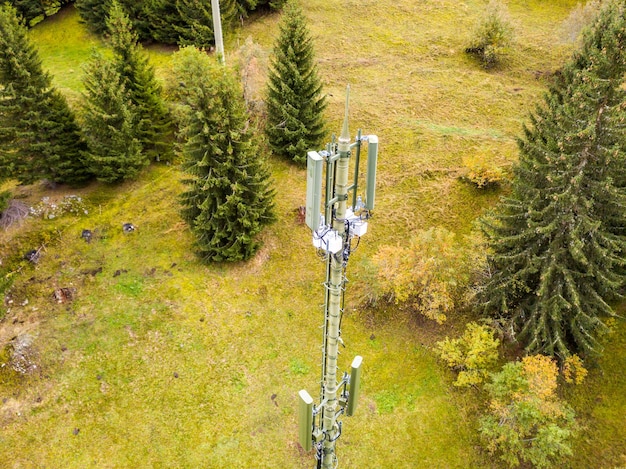Federal Infrastructure Bill Update: Tracking Broadband Expansion Funds

The Federal Infrastructure Bill, officially known as the Infrastructure Investment and Jobs Act, allocates significant funding for broadband expansion across the United States, aiming to bridge the digital divide and enhance internet access for underserved communities.
The **Federal Infrastructure Bill Update: Tracking the Allocation of Funds for Broadband Expansion** is crucial for understanding how this landmark legislation is transforming internet access across the United States. With billions of dollars earmarked for broadband projects, it’s essential to know where the money is going and what impact it’s having on communities nationwide.
Understanding the Broadband Provisions of the Infrastructure Bill
The Infrastructure Investment and Jobs Act, signed into law, includes substantial provisions aimed at expanding broadband access. These provisions address key issues such as affordability, infrastructure development, and digital equity, setting the stage for transformative changes in the nation’s connectivity landscape.
Key Broadband Programs Funded
Several programs within the bill are designed to directly support broadband expansion, each with a specific focus and funding allocation. Understanding these programs is crucial to tracking the bill’s impact.
- Broadband Equity, Access, and Deployment (BEAD) Program: This program provides grants to states and territories for broadband planning, deployment, and adoption.
- Affordable Connectivity Program (ACP): Offering subsidies to low-income households to help them afford internet service and connected devices.
- Digital Equity Act Programs: Supporting digital inclusion projects that provide training, devices, and other resources to underserved populations.
These programs collectively aim to address the multifaceted challenges of broadband access, ensuring that all Americans have the opportunity to participate in the digital economy.
The focus shifted from just access to incorporating programs that address the digital skills gap like digital literacy and affordability. The digital equity act aims to help train traditionally excluded groups of people to use technology in their day-to-day activities, and their career.

Tracking the Allocation of Funds to States
One of the most critical aspects of the Infrastructure Bill is tracking how funds are allocated to individual states. This allocation process determines which areas receive the most support for broadband expansion. Many states have identified those underserved as low-income and rural communities.
Factors Influencing Funding Allocation
The allocation of funds is influenced by several factors, including population density, existing broadband infrastructure, and the number of unserved or underserved locations. Data from the Federal Communications Commission (FCC) plays a key role in determining these allocations.
States are required to submit detailed plans outlining how they intend to use the funds, ensuring that projects align with the bill’s goals and priorities. These plans must address key issues such as affordability, sustainability, and community engagement.
Funds are designated towards public-private partnerships that encourage the improvement of service availability and access. Encouraging the use of different technologies to come up with solutions tailored to each communities unique needs.
Examining the Impact on Rural Communities
Rural communities stand to benefit significantly from the Infrastructure Bill’s broadband provisions. Many rural areas currently lack access to high-speed internet, hindering economic development, education, and healthcare opportunities.”
- Economic Growth: Broadband access can stimulate economic growth by enabling e-commerce, remote work, and access to online markets.
- Educational Opportunities: Students in rural areas can benefit from online learning resources and remote educational programs.
- Healthcare Access: Telehealth services can improve access to healthcare for rural residents, especially those with limited mobility or transportation options.
By prioritizing rural areas in broadband expansion efforts, the Infrastructure Bill aims to bridge the digital divide and create more equitable opportunities for rural communities.

Addressing Affordability and Digital Equity
Beyond infrastructure development, the Infrastructure Bill recognizes the importance of affordability and digital equity. Access to affordable internet service and digital literacy programs is essential for ensuring that all Americans can benefit from broadband expansion.
The Affordable Connectivity Program (ACP)
The ACP provides subsidies to low-income households to help them afford internet service and connected devices. This program is a crucial component of the effort to address affordability barriers.
ACP subsidies cover the difference between market costs of broadband versus what lower income people can afford. Internet service providers are encouraged to provide better equipment at a lower cost in these cases so that their prices are more competitive.
The government is incentivizing a multitude of service providers through this program to ensure there is better overall competition and prices are driven down.
Potential Challenges and Obstacles
While the Infrastructure Bill presents significant opportunities for broadband expansion, there are also potential challenges and obstacles to consider. These include regulatory hurdles, workforce shortages, and supply chain disruptions.
- Regulatory Approvals: Obtaining necessary permits and regulatory approvals for infrastructure projects can be a time-consuming process.
- Workforce Shortages: A shortage of skilled workers in the telecommunications industry could slow down deployment efforts.
- Supply Chain Issues: Disruptions to the supply chain could affect the availability of essential equipment and materials.
Addressing these challenges will require proactive planning, collaboration among stakeholders, and innovative solutions.
One potential solution for supply chain constraints is the manufacturing of electronics and raw materials domestically. This is encouraged through economic policy that promotes local development of these high tech products.
Measuring the Success of Broadband Expansion
Measuring the success of broadband expansion efforts requires a comprehensive approach that considers various factors, including coverage, speed, affordability, and adoption rates. Data collection and analysis are essential for tracking progress and identifying areas that need further attention.
- Coverage Metrics: Tracking the percentage of households and businesses with access to high-speed internet.
- Speed Metrics: Monitoring average download and upload speeds to ensure that broadband service meets minimum standards.
- Affordability Metrics: Assessing the impact of affordability programs on reducing the cost of internet service for low-income households.
By establishing clear metrics and monitoring progress closely, policymakers and stakeholders can ensure that broadband expansion efforts are achieving their intended goals.
It is also important to measure the quality of the infrastructure being added and improved and to compare this data with that of other high performing countries. This can further help inform policy makers on the strengths and weaknesses of the program, and show where more attention needs to be focused.
| Key Point | Brief Description |
|---|---|
| 💰 BEAD Program | Grants for states for broadband planning, deployment, and adoption. |
| 🫂 ACP Program | Subsidies for low-income households to afford internet service. |
| 🍎 Digital Equity | Support for digital inclusion projects and training programs. |
| 🌍 Rural Impact | Focus on bridging the digital divide in rural communities. |
Frequently Asked Questions
▼
The BEAD Program provides grants to states and territories for broadband planning, deployment, and adoption, aiming to increase internet access across the nation. It focuses on unserved and underserved locations.
▼
The ACP offers subsidies to low-income households, helping them afford internet service and connected devices. This reduces the financial burden and promotes digital inclusion.
▼
These programs support digital inclusion projects by providing training, devices, and other resources to underserved populations. The programs aim to ensure everyone has the skills to use the internet effectively.
▼
Rural communities will benefit from increased access to high-speed internet, stimulating economic growth, creating more educational opportunities, and enabling telehealth services for residents.
▼
Challenges include obtaining regulatory approvals, workforce shortages in the telecom industry, and potential supply chain disruptions affecting the availability of necessary equipment and materials.
Conclusion
Tracking the allocation of funds from the Federal Infrastructure Bill for broadband expansion is crucial for ensuring equitable access to high-speed internet across the United States. By understanding the bill’s provisions, monitoring the distribution of funds, and addressing potential challenges, we can work towards bridging the digital divide and creating more opportunities for all communities.
